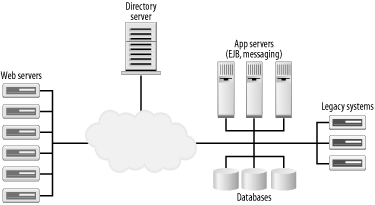Finding Resources
A presentation tier is only as good as the data it has to present. In some applications, finding data is as simple as instantiating the appropriate business delegate and calling a method. But life gets complicated when an application grows to encompass a range of resources that are spread across a number of services. To help manage distributed components, J2EE specifies that they should be connected via the Java’s directory API, JNDI. JNDI is a simple, standard API that allows communication with a variety of directories such as LDAP and NDS. Using a directory server, clients are somewhat shielded from the complexities of distributed environments. The canonical J2EE picture is shown in Figure 9-10.
 |
The nice thing about a directory is that a client can get a reference to a resource anywhere on the network, remote or local, with a single lookup. This decouples the client from a particular server implementation. Of course, there is no such thing as a free lunch, and anyone who has actually built a distributed J2EE environment knows that all we have done is shift a development headache to a deployment headache.
Finding resources on the network has performance implications. Connecting to a remote EJB might first require querying the directory server for the EJB’s location. While the cost may not seem substantial, we effectively ...
Get J2EE Design Patterns now with the O’Reilly learning platform.
O’Reilly members experience books, live events, courses curated by job role, and more from O’Reilly and nearly 200 top publishers.

